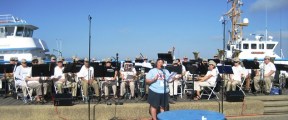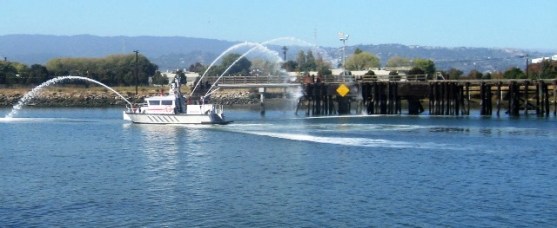|
|
Two Dredging Projects Scheduled To Begin in November
|
Two dredging projects will begin in November:
1) The US Army Corps of Engineers (ACE) has a contract with RE Staite for channel operations and maintenance dredging. The $10.3 million will start Nov. 15 and will operate 24 hours a day. The dredging is expected to be completed by late
|

|
|
Recreational boaters are warned that dredges and other equipment will occupy the entire channel
|
January but is authorized to go through March 1.
2) The Port Commission recently approved a $1.5 million contract for ship berth operation and maintenance dredging at wharves 1-4 with The Dutra Group. The scope of work for this project includes dredging the berths to a design depth of -34′ MLLW. It will begin Nov. 10 and finish Dec. 1.
The channel dredging will restore the channel to its authorized depth of minus 30 feet for the first time since 2009. The bigger Panamax ships bringing construction materials to the Port have deeper drafts. Maintaining the channel at its fully authorized depth is critically important to increase the transpiration efficiency of these bigger ships. Also, deeper drafts for these ships mean they can make a few less Port calls and still provide the same amount of construction materials. This lowers the air emissions in the Bay Area from these ships and the tugs that dock them in Redwood City.
The ship berth dredging will be completed before the channel dredging. The berths are maintained at deeper depth, minus 34 feet, than the channel in order to provide better maneuverability for the vessels at dockside.
The port’s tonnage has been steadily increasing since 2009, averaging 1,750,150 tons the past two years. The majority of imported cargo is construction materials to supply the many major construction projects, underway and planned for the Redwood City area and Silicon Valley. The majority of exported cargo is recycled metals.
The Port staff recently conducted a safety meeting for recreational sailing and rowing groups, which also included participation by the contractors, USACE, and U.S. Coast Guard.
The channel dredging will have two derrick barges, four or five scows, tug boats, anchor handling boats, crew boats, and survey and monitoring vessels. Recreational boaters are advised to stay at least 100 yards from the dredge barge and scow at all times during dredging operations. The dredges occupy the entire channel. The channel also will have anchor buoys and cables.
“This is one of the least glamorous, but most important jobs the Port has,” said Port Commission Chairman Dick Clair.
|
Commission Elects Dick Claire Chairman
|
Richard “Dick” Claire has been elected chairman of the Port Commission, Simms Duncan
|

|
|
Dick Claire
|
vice-chairman, and Richard “Dick” Dodge secretary.
Claire, who was first appointed to the Commission in 2007 and reappointed in June 2012 for a four-year term, had served 21 years on the Redwood City Council, including four as mayor, and seven years on the Redwood City Planning Commission.
Duncan was appointed to his first term in 2014. Duncan is an active volunteer and Redwood City community member including nine years with City Trees. He is a graduate of the Redwood City Citizens Police Academy and Redwood City PACT program.
|

|
|
Simms Duncan
|
Dodge, who originally was appointed in 1980 and reappointed seven times since, is one of the longest current consecutive serving port commissioners in the United States.
|

|
|
Dick Dodge
|
|
Port Tonnage Report for 1st Quarter of Fiscal year
|
Total tonnage for all commodities crossing over the Port’s docks during the first quarter of Fiscal Year 2015-16 was 392,237 metric tons, 13%, below the first quarter of FY 15 (451,031MT).
Approximate percentage breakdowns by commodities: imported sand 41%; imported aggregates 31%; exported shredded scrap metal 15%; imported gypsum 9%; imported ground slag 2%; and the remaining 2% consisted of domestic sand.
Sand and aggregates continue to be at a high demand for the local ready-mix concrete suppliers.
Port Operations Manager Don Snaman reported that 27 vessels (12 ships, 15 barges) made calls during the first quarter of FY 16 compared to 29 vessels (15 ships, 14 barges) during the first quarter of FY 15.
|
PortFest Images (Which Was Held Oct. 3)
|
|

|
|
Exploring Coast Guard Cutter Sockeye
|
|

|
|
Little Boy looking at MSI shark tank
|
|

|
|
PortFest visitors enjoying booths
|
|

|
|
Live Wire Band a crowd favorite
|
|
PortFest Enjoyed a Large Crowd:
|
|

|
|
Miss Redwood City/San Mateo County Emily Mcniel, visiting with Rita Artist, the Port’s Executive Assistant/Clerk of the Board (right) and Margaret Astesano, the Port’s Executive Assistant/Administration
|
|

|
|
Father & Son explore Coast Guard Cutter Sockeye
|
|

|
|
West Bay Community Band
|
|

|
|
Mayor Jeff Gee gives opening remarks
|
|

|
|
Port Commissioner and Port Fest Organizer Lorianna Kastrop welcomes crowd
|
|
|

|
Redwood City police and fire officials address PortFest crowd
|
PortFest Photos by Mike Kastrop & Port staff
|
|

|
|
Redwood City fire boat demonstration
|
|

|
|
Trolley took visitors on tours of Port industrial businesses
|
|

|
|
PortFest Shuttle to CalTrain
|
|
|
|
The American Association of Port Authorities (AAPA), of which the Port of Redwood City is a member, has launched a national campaign to urge members of Congress to keep freight moving by supporting a six-year transportation reauthorization bill that contains robust freight provisions and adequate, sustainable funding for our nation’s freight transportation infrastructure.
This important to the shipping industry because once goods reach the docks, they are transported by truck and rail to their destinations. Final legislation must address critical “first and last mile” port connections and support viable trade corridors, according to AAPA President Kurt Nagle.
Freight provisions in the bill must be fully funded, he added.
Seaports like the Port of Redwood City are vital to the U.S. economy.
- The total value of economic activity related to America’s seaports last year was $4.6 trillion, or about one-third of the entire U.S. economy, and is projected to reach 60% by 2030.
- In 2013, 1.3 billion metric tons of imported and exported cargo worth nearly $1.75 trillion moved through America’s seaports.
- America’s seaports handle approximately $6 billion worth of goods moving to and from overseas markets each day.
- An estimated 900 million metric tons of domestic cargo with a market value of over $400 billion was also handled through U.S. ports.
- U.S. seaports generated more than 23 million jobs and $321 billion in tax revenue in 2014.
Yet, critical freight connections are at risk. Freight connections to U.S. ports – critical links in America’s transportation infrastructure – are falling behind 21st century needs, putting jobs at risk and reducing America’s global competitiveness.
“First and last mile” connectors – including roads, railways, bridges and tunnels – serve as vital links between seaports and other segments of the nation’s freight transportation network.
Congestion is hurting port productivity and threatening communities. One-third of ports say congestion at landside connectors over the past 10 years has caused productivity to decline by 25 percent or more.
The convergence of growing freight volumes and residential needs stresses transportation infrastructure, resulting in road and rail congestion, air quality and safety issues, and negative quality-of-life impacts in adjacent communities.
Nearly 80% of AAPA’s U.S.-members ports require at least $10 million investment in their landside connectors through 2025; 31% require over $100 million. While ports plan to invest more than $9 billion each year to maintain and improve infrastructure, additional investment is needed to improve road, rail, bridge, and tunnel connections at U.S. seaports.
Link to draft National Freight Strategies Plan released Oct. 18:
https://www.transportation.gov/sites/dot.gov/files/docs/DRAFT_NFSP_for_Public_Comment_508_10%2015%2015%20v1.pdf
|
|
Port of Redwood City | 675 Seaport Blvd | Redwood City, CA 94063
 
|
|
|
|